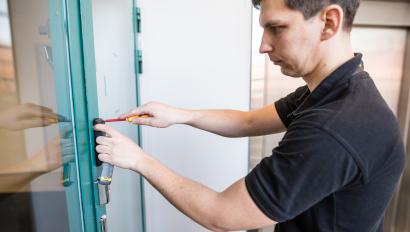Managing Physical Security in Today’s Remote Environment

For years, security systems have been a collection of panels, sensors, cameras and card readers that protected your facility, but also required complicated installation and maintenance. Changes and updates to these systems had to be done at the server or at the keypad. Maintaining the system was a series of checks – both visually and through software – to ensure things were working correctly.
If you were away for a week, chances were that you’d return to stories about a door not working or how a camera stopped recording. Hard drives in old recorders went bad and you could lose a month of recorded footage if a power surge took out your digital recording device. When something stopped working, there were multiple service calls and hours of on-site repair being done.
Times have changed. We can do more remotely now than ever before. Remote security is comprised of numerous options within each dimension of your electronic security system. This blog will go through various technologies and what you should consider in order to secure your facility and maintain the health of your system without ever stepping foot on-site.
Intrusion Systems
Security keypads are simple to the untrained eye, but learning to program a user or delete a user is both time-consuming and an error-laden process. If you hit one wrong key, you are likely starting over.
Modern intrusion systems often employ mobile applications for remote arming and disarming. Your security provider might have a mobile application that allows you to place your system into test, change users and verify alarm history. What used to be a phone call to a service department is now a quick message through your application. Who is arming and disarming your system while you are away from your business? Find out instantly on your mobile device.
Access Control Systems
Many of us are out of our offices and working from home. If an employee quits, are you making changes to their access privileges while you are at home, or are you putting it on a sticky note for when you return to work? What is keeping them from visiting the facility between now and then?
If you have asked your employees to work from home and stay out of the office, what is preventing them from going by anyway? Has your door schedule been updated, or is that another task you need to be on-site to manage? Remote access to your server is a key component of making adjustments in real-time that can protect your business now and in the future.
When a door stops working in a building that is fully staffed, it is usually detected within a day or two. A building with minimal staff or only security and service teams might not find it for a week or two, or worse yet, they may not find it until it is an emergency situation and they cannot access the building or room in that moment. Monitoring the condition of your access control system is vital when you are not on-site.
Video Surveillance Systems
When we talk about monitoring the condition of your system, one of the first things that comes to mind is video. As many of us continue to work remotely, being able to view camera systems for our business is of paramount concern. It is our method of being there when we can’t physically be on-site.
Access control systems may keep most people out, and intrusion systems alert the authorities, but video can be our eyes into the situation. How easy is it for you to view your video surveillance feeds while you’re away from the office?
Video surveillance is most commonly used as evidence. Having somebody sit and watch your cameras 24/7 is costly and not an efficient use of an employee’s time in low-risk facilities. Typically, you are looking for video around a specific incident that has been reported. What happens when you are looking for that video and it can’t be found, or you discover that the camera hasn’t been recording?
Hard drive failure is a thing of the past as more businesses move to cloud video infrastructure. For those companies that have limited space or don’t want to manage a physical server on-site, it’s becoming increasingly easier to migrate your cameras to secure cloud storage that you can access from anywhere.
Routine health checks on these systems are a recommended practice, but technology can have day-to-day changes and issues and unless you are consistently checking your cameras, an issue could occur that you may not see for a week.
You don’t have to be surprised by missing video. Put a system or solution in place that alerts you to issues with cameras or access doors as they happen in real time, or even indicators leading to those issues before they shut down part of your system. If your system is complex and difficult to troubleshoot and fix on your own, do you have a team of experts that you can reach out to for assistance?
Security for your business can’t take a back seat while you’re off-site. Remote technologies and capabilities in the security space are more prevalent than ever before and utilizing these options can help give you peace of mind as you continue your remote work.
Disclaimer: By using the Blog section of this website (“Blog”), you agree to the terms of this Disclaimer, including but not limited to the terms of use and our privacy policy. The information provided on this Blog is for information purposes only. Such information is not intended to provide advice on your specific security needs nor to provide legal advice. If you would like to speak to a Security representative about your specific security needs, please contact us.






















